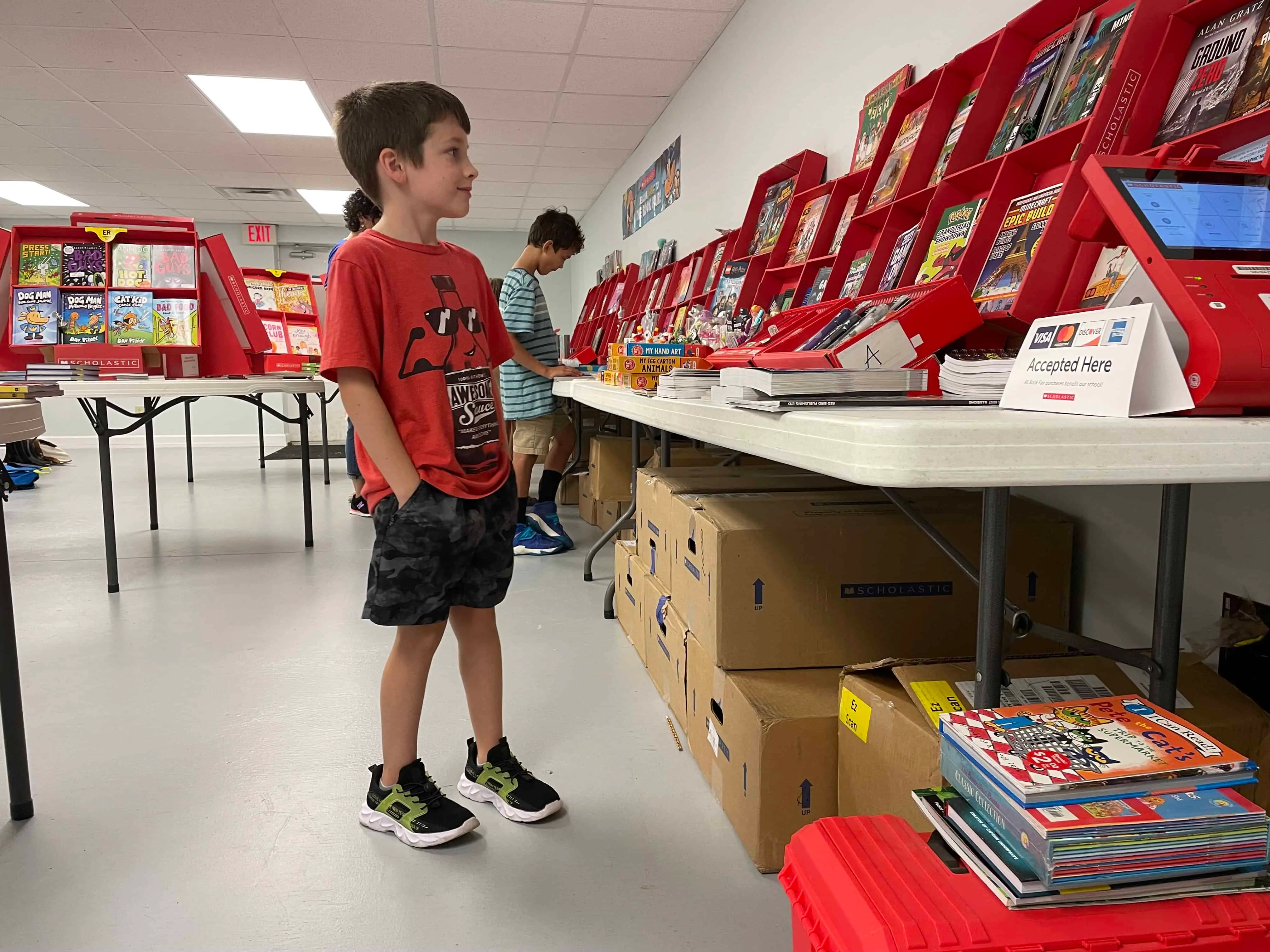Yearbook curriculum
Looking for inspiration, design tricks, how to make a great cover, promoting your yearbook and engaging your community?
Most recent

Essential yearbooking gear
One of the top questions we see in yearbook adviser and yearbook coordinator Facebook groups involves yearbook gear such as cameras and organizational supplies. Using a combination of funds from budget money, yearbook fundraiser proceeds, or a grant, you can build a media room that achieves your goals.
This list is not meant to be comprehensive, rather a smattering of options. Tailor your shopping list to match your program’s goals as well as your population. Do you really want your elementary yearbook club students passing around a $2000 camera? Conversely, should your competitive high school team aim for a Pacemaker with just point and shoot cameras?
Cameras
Camera bodies
The camera body, or box, is where half the magic happens: the shutter release, mirror, viewfinder, and controls live on the box on a digital single-lens reflex (DSLR) camera; see mirrorless camera below if your head is going to explode. Your yearbook photographers will control the settings here.
Purchasing a camera kit from a big box store or online may seem like a great deal. The lenses that accompany those kits usually aren’t “fast” enough to take photographs in the gym or an auditorium when the light tends to be tricky.
A used camera kit from a resale website is always an option for schools looking to buy yearbook equipment with limited funds. Save the money for a fabulous lens that will help you get the sharp images you want. Most bodies built in the last 5-10 years will have the ISO, autofocus, and shutter speed capabilities you need, even for those frustrating low-light gym photographs.
Some great beginning boxes are:
- Canon Rebel
- Nikon D3500
Mirrorless cameras
Being lighter, and a potentially less expensive investment, mirrorless cameras are slowly replacing some DSLRs in yearbook classrooms. Mirrorless cameras will help emerging photographers because there isn’t as much gear to tote and they can look less intimidating.
Highly recommended mirrorless cameras:
- Canon R6
- Nikon Z6
Lenses
In many cases, investing in a lens aka glass will be more critical than a body. If all your school’s sports are outside, then the lenses that come in your kit will be perfect. If you photograph volleyball and basketball in a gym or musicals in a dark auditorium, then you are going to want a lens that can use the full ISO, aperture, and shutter speed range of your box. When buying any lens, make sure it marries your box. There are some off-brand lens brands such as Sigma and Tokina that are less expensive than their Canon and Nikon counterparts.
Two lenses to have
- 35-70mm f/2.8
- 50mm f/1.8 (more on the nifty fifty below)
Nifty fifty
If you add anything to your cart this year, make it a 50mm lens. The depth of field and low-light capabilities you have are what the young people deem clut


Lens cleaning essentials
Each camera bag in your yearbook program should contain a camel hair cleaning brush.
Pro tip: A pencil eraser is a great tool to keep in each camera bag to clean the battery connectors.
Photography essentials
Lens filter
These aren’t the photo-destroying filters your social apps provide, but screw-on glass filters for camera lenses. Use this circular filter for cutting glare and reducing light specifically with outdoor photos. Before setting out on a yearbook assignment with a polarized filter, take some time to play with it. Because it increases color saturation and cuts bright spots, it takes some time to learn.
Reflector
Reflectors, next to the nifty fifty, are one of the best, inexpensive photography items your yearbook program can use. They help you control light for outside portraits (think of fun ways you can take those pull quote pics up a notch) and also maximize limited lighting when doing studio shoots. A fun, and less traditional way to use a reflector is as a background.
Ring light
With mini ring lights being a cell phone staple in the early stages of influencers, pros have used the big ones for years. Ring lights surround your subject and eliminate most shadows over which three-point lighting enthusiasts geek out. (If you play around with your ring light and reflector, you can simulate the three-point look!) They make eyes pop.
The best ring lights are at least 18”, and they come with both warm and cool light settings as well as a dimmer. Some tripods also have cell phone and tablet holders in addition to the traditional quick-release plate.
Studio kit
Studio kits look impressive, but are they essential yearbook gear? Here’s how we’ve seen Treering advisers use studio kits:
- Class favorites, superlatives, or standouts
- Photo illustrations
- Pull quote portraits
- Retakes when your pro photographer won’t come back for a third (or fourth) shoot
- Setting up a photo booth at dances and school-wide events for a fundraiser
Many of the kits you can buy pre-packaged online will suffice for your yearbook program. Soft boxes vs. flashes are something to consider when looking at the rest of your gear.

Memory cards and card readers
Memory cards are temporary storage. They are temporary storage. Memory cards are not permanent storage. Phew! PSA over.
WiFi SD cards are game changers for busy yearbook staffs: they transfer files from your camera to the predetermined storage space without cables and card readers. Some cards even have an app so you can review photos on the spot. These make for effective teaching moments.
If you don’t have the budget or tech capacity, for something like wifi cards, it is nevertheless imperative to buy at least two memory cards per camera bag. Make sure you have a card reader in each bag as well as a card reader on each computer in the yearbook or media room.
Additional Yearbook Gear
- Rain Sleeves: keep your camera dry during outdoor events, such as soccer matches, in inclement weather
- Cell Phone Lenses: clip-on lenses run less than $30 and can add wide-angle, omnidirectional (aka 360), or fish eye capability to most smartphones. We love these for fun runs, homecoming rallies, and school carnivals.
Yearbook/media room
Yearbook gear is not limited to photography equipment. In fact, providing environmental tools is as essential as camera gear.
Cubbies and mailboxes
Magazine holders from the dollar store or cast-offs from the front office make great boxes for your students. Use them to send out important communications, such as emails from teachers regarding upcoming classroom events or new SD cards. Students can also use them for gift exchanges, camera check out, and peer edits.
Notepads
Doodling, brainstorming, and note-taking on paper are healthy parts of the creative process. In the early planning days, practice both digital and paper-based workflows so your team can decide which works best for them.
Mini fridge and snack subscription
An exclusive yearbook fridge in the corner of your classroom becomes a perk of the position. Waters, juices, and the occasional box of popsicles serve dual purposes: appreciation and fuel. Involve parents in keeping it stocked: at back-to-school night, start a signup sheet for yearbook parents to supply your students with snacks each month. Parents may even opt to share the cost of a snack subscription service.
Coffee maker
This is as much for you, Yearbook Adviser, as it is for your team. (And if you’re getting exasperated with us for suggesting you give children coffee, remember, cocoa pods and tea pods exist as well.) The point is to create a warm, hospitable environment for the hardest working people on campus.
Bulletin boards
This is where you brag on your students by sharing a photo of the week and any awards they may have earned. Pin thank you cards and any positive emails you receive regarding the yearbook for all to see.

Unreliable volunteers: when your yb co-chair goes dark
You planned your year and recruited your team. Roles are set. Parents and teachers are submitting photos. And then, an unreliable volunteer sets back your yearbook exponentially. Take heart: you’re not the first yearbook adviser to experience this!
Volunteer unreliability factor 3/10 - deer in the headlights
Ready, set… nothing. Whether fear of failure or a general spirit of uncertainty are acting as hindrances, it’s time to step in as a coach. Let’s face it, many of our parent volunteers are publishing and journalism amateurs. Take some time with the new recruits to show not tell: design a layout together, photograph an event together, get students' quotes together. Build confidence! Consistent communication, including genuine appreciation, inspires unity and helps volunteer yearbook staffers push on towards your goal.
Volunteer unreliability factor 7/10 - oops… (s)he did it again
Early detection, while uncomfortable, can eliminate problems later on. The first time someone is a no-show, address it (kindly).
When you do get that face-to-face moment, maintain your professionalism:
- Communicate with specifics: instead of “You’re always unreliable,” try “You volunteered to take Fun Run photos and did not have a backup in place when you were a no-show. What is your plan to get pictures?”
- Keep it focused: the conversation should center around yearbook responsibilities and not on personal issues. You’re not meeting to be a relationship counselor, life coach, or even a friend. You’re a project manager looking to complete a job.
- Be proactive: document what will happen next. If your yearbook co-chair wants to remain in the role, write out what it will look like with clear expectations and deadlines. Also include an “out” clause if your volunteer continues to be unreliable.
A word of caution: it’s easy to fire off a text or email, and like we tell our children, easy isn’t always best. As we know, much of communication is non-verbal, so a face-to-face session allows you (and your volunteer) to assess body language and tone.
Volunteer unreliability factor 10/10 - the worst-case scenario
What do you do when a volunteer up and quits in the middle of your yearbook and is unreachable, unresponsive, and, frankly, unrepentant?
- Plan for human error and phone a friend
Within your yearbook staff, build in a group of utility players; this may be a working mom who cannot help at every event or a school secretary that does too much already. Have a few friends you can call to help with one-off tasks. The leader of your parent org may have a list of volunteers to plug in. - Promote from within
Your next yearbook co-chair may just be on your staff already. Once you’ve communicated the need—again using specific, job-focused language—the team may have a solution! (You recruited the best for a reason!) - Flip your lid
Not really. It was just fun to write. - Remember your purpose
As cliche as it is, remember the kids. It’s the students who will open the yearbook you helped create, pour over its pages, and never once reminisce on the unreliable volunteer who temporarily thwarted progress. Why? Because you're a project manager who completed the job.

Using the "five common topics" for yearbook copy
The inverted pyramid is the go-to launch point for budding journalists. (Anyone else hear a journalism teacher’s voice: “Don’t bury the lede!”) For these emerging writers, filling each level equates to squeezing the five Ws into its ranks. This could lead to repetitive or restricted writing. The “easy” fix: asking better questions.

Integrating the five common topics with the inverted pyramid structure helps students create engaging yearbook copy because it models inquiry. They move beyond “What was your favorite…?” They create questions with analytical depth. They craft stories worth reading.
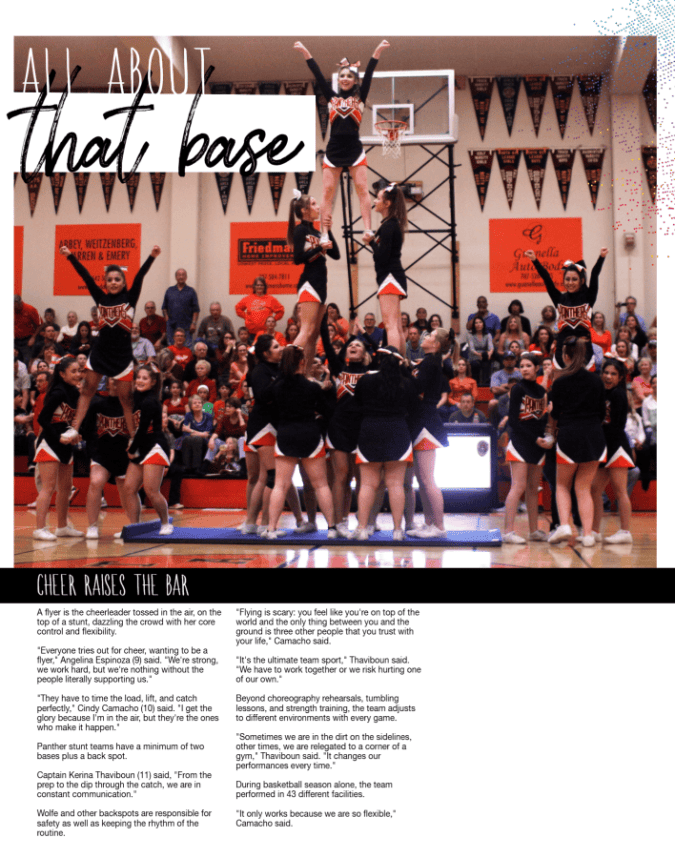
What are the five common topics?
How would the ancient Greek and Roman orators write a yearbook story? (That might as well be under “Adviser questions I’ll never ask for 1000, Alex.”) The five common topics are definition, comparison, relationship, circumstance, and testimony. The early scholars used this method of inquiry to discuss, persuade, and analyze. Developing yearbook interview questions based on the five common topics can be a structured way to gather information and insights.
Definition
The five Ws fall here: the topic of definition breaks down your subject into key components. What it is and who does it. Where it takes place. Why it’s important. When it occurs.
What is a clear definition of [the subject]?
This is extremely helpful for students when they craft copy on an unfamiliar topic. For example, most people use “bump, set, spike” somewhere on a volleyball spread. We don’t bump. We pass.
How would you characterize the key features that distinguish [the subject] from other similar concepts?
Each game, dance, movie night, and fun run is unique. So are labs, presentations, debates, and study sessions. Find out what sets this event or activity apart. By defining what it is holistically, you are also defining what it is not: just another day. (Remember, there is a reason for this story beyond an opening in your page template.)
What are the essential elements that makeup [the subject]?
Sports and arts copy can always be improved by understanding the technique. Start with your photos and ask the stakeholders to explain what they are doing step by step. Define tools, from cleat spikes to microscopes, and their use.

Back to our volleyball example: She’s aligning her feet to the setter and positioning her body so her belly button is behind the ball. Straight arms and little-to-no movement are key for her to give a high pass the setter can push to the outside hitters or run a quick hit from the middle. She starts each practice by passing 50 free balls as an offense-defense transition drill.
No bumping is involved.
Comparison
The next step is to expand upon the basics by drawing parallels or highlighting differences. Using analogies, journalism students can make complex ideas understandable. Sometimes, it helps to take the opposite approach and point out key differences.
In what ways is [the subject] similar to [another relevant entity], and how are they different?
Familiarity is comfortable. By relating new topics to known ones, you can ease your reader in.
Are there instances where lessons from [a related concept] can be applied to [the subject]?
Again, even though chemistry class repeats the gummy bear lab annually, it is not the same year after year. The same can be said about an AP class preparing their art portfolios or a Link Crew orientation.
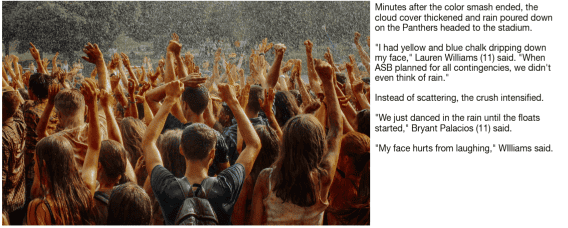
Using the topic of comparison, student reporters have a reason to cover recurring events–they are digging into the differences.
How does the comparison to [another relevant entity] enhance our understanding of [the subject]?
Keyword: enhance. Comparison is valuable if it adds value. And before you flinch at the intended redundancy, remember new writers need to evaluate their notes as part of their process. Listing related and opposing concepts will also strengthen the topic of definition.
Relationship and Circumstance (This is a Twofer)
I’m combining topics three and four. Event sequences, cause-and-effect relationships, and the outcome of the event all have a place at the proverbial table. Understanding circumstance helps in tailoring yearbook copy to be more relevant and effective because we use it to examine the context of each story. It’s the here and now. These details help readers understand why the event is significant at this moment.
What current events or trends are influencing [the subject]?
More than the water bottle du jour, the timeliness of a yearbook story gives its place in your school’s historical record. You give campus events context by relating them to the community or even the world.

Are there specific challenges or opportunities related to [the subject] that are particularly relevant now?
In the example above, a student gave a speech. This is a daily occurrence around the globe. The author used the subject’s reported challenges and testimony (spoiler alert: that’s topic #5) to illustrate what led to the moment.
Chances are, this story wouldn’t have been printed in your mom’s yearbook. The circumstance was different.
Can you identify any cause-and-effect relationships associated with [the subject]?
Part of contextualizing your yearbook stories is adding what resulted from the story. Did the fundraiser set a new record? Athlete return for her final game of the season? AP Language class win the literary food festival? Wrap up your story.
Testimony
“Give me a quote for the yearbook.” Next to definition, testimony is the most commonly used of the five common topics. It’s the human element. Including testimonies from different sources helps balance the story, gives authority to student writing, and showcases varied perspectives.
While it’s the fifth topic, when students write, they should incorporate the questions below.
What diverse perspectives contribute to a more comprehensive understanding of [the subject]?
Scores, stats, fundraising figures, and meaningful quotes enhance credibility and give voice to yearbook copy.
How do you navigate conflicting testimony or opinions from authoritative sources regarding [the subject]?
The short answer: ask more questions. How do you find out what is true and who do you ask? (This could be more common with sporting events over bio labs.)

Testimony: Add relevant quotes from participants or spectators to illustrate.
Relationship and Circumstance: Explain what factors led to the event and how it impacted the school community.
Testimony: End the story by adding additional quotes or data to add depth and credibility.
Example structure for the inverted pyramid and five common topics
Let’s start with this photograph of four students on the green.

To come up with the copy, students identified:
- Names of students and their grades
- Location of photo
- What is going on
- Background on Xilam
- What aspect of Xilam is shown in the image
- Relationships between Mexican martial arts and Spanish for native speakers class
- How many languages–and which ones–are spoken on campus
This structure delivers both the essential information layered with insights. It moves beyond a listing of the 5Ws because it begins with inquiry.

12 ways your yearbook class makes students career-ready
It's no secret to seasoned advisers that yearbook class is one of the most accurate career-preparation courses available to students. The yearbook-building process meets all of the national Career-Ready Practices. We’ll go through each below with practical application ideas for yearbook classes.
1. Act as a responsible and contributing citizen and employee.
How to do it: teach project management skills by having students pre-plan their weeks.
Weekly goal-setting and check-ins maintain a culture of accountability while building executive functioning skills. First, project your ladder and page assignments. Then, reverse engineer some major milestones. From there, students can set a goal, calendar important dates, and pre-plan how they will meet their deadlines. Do this corporately so each student can see his/her contribution.
2. Apply appropriate academic and technical skills.
How to do it: equip your students with tools and training for their age, ability, and your yearbook mission.
Keep in mind, a first-year yearbie/yerd/yearbook student should have a different skill set than a third-year one! Returning staffers are excellent resources to teach skills, especially those on your editorial board.
3. Attend to personal health and financial well-being.
How to do it: schedule in the fun!
Because you corporately planned the year, you already know when the pinch points are going to be. Plan a few fun days before and after to help students relieve stress, and show them the importance of balance.
Also, be transparent about finances. Your yearbook students should know how much it costs to produce their yearbook. Likewise, they should know financial goals (book and ad sales) and celebrate their achievement.
4. Communicate clearly, effectively, and with reason.
How to do it: begin the year with a plan.
All the work you do from a syllabus to the page ladder and assignment provides the overarching structure. Bi-weekly editorial meetings and all staff meetings should include check-ins, deadline assessment, and teaching moments to provide accountability and hone these skills:
- Model how to email teachers and coaches by providing templates or examples of wording.
- Practice interviewing.
- Show, rather than tell, how to enter a class to pull a student for a quote or photo opportunity.
- Set expectations and boundaries for yourself and your team.

5. Consider the environmental, social, and economic impacts of decisions.
How to do it: create worthwhile partnerships.
These are Treering’s core values. From sustainably sourced printing materials to partnering with charities, the environmental and socio-economic impact of a yearbook transforms lives. Additionally, ethical reporting and creating an inclusive yearbook are hallmarks of positive social impact.
6. Demonstrate creativity and innovation.
How to do it: make a yearbook.
(We’re just going to leave this one here.)
7. Employ valid and reliable research strategies.
How to do it: make before, during, and after your journalistic mantra.
What we see in many yearbooks are photographs of the actual events, and we miss ASB creating poster after poster for spirit week, Mr. Watts cleaning up until 2 AM, the baseball team volunteering to haul hay bales, etc.
Ask your team:
- What preparation goes into [the event]?
- Who is involved?
- What is the impact of [the event]?
- How can we capture this?
At the interview, ask:
- What don’t people know about [the event]?
- How do you prepare for [the event]?
- How much time do you invest?
- What happened after [the event]?
Also, coverage doesn’t have to follow the traditional photo/caption format. Create infographics and polls, show game statistics and team scoreboards, and use quotes from differing perspectives to tell the story of your year.

8. Model integrity, ethical leadership and effective management.
How to do it: the old adage It starts at the top applies here.
Module 2 of Treering’s free curriculum will help you unify your team and build trust.
9. Plan education and career path aligned to personal goals.
How to do it: toot your team’s proverbial horn.
Using the yearbook job descriptions in Treering’s curriculum guide, work with your team to create resumes, detailing their job experience in yearbook class. While many think, “I put pictures on paper,” they don’t see things like:
- Scheduled photographers for event coverage
- Experienced in copy editing, reporting, and layout design
- Promoted publication on social media, in print advertising, and at community events
- Worked within deadlines to maintain $20,000 budget
It’s our job, advisers, to show them their impact! Then show their parents. Then show your administration.
10. Use technology to enhance productivity.
How to do it: post and track your goals.
Your yearbook software plus a digital planning tool such as a Gantt Chart in Google Sheets or a Trello board will keep you on track.
11. Utilize critical thinking to make sense of problems and persevere in solving them.
How to do it: make a yearbook, part 2.
What do you do when a photographer does not show up for a game? How do you handle an event being canceled or rescheduled? What do you do when someone accidentally reformats a card prior to photos being uploaded? The yearbook creation process is all about pivoting. Build in contingencies by creating evergreen content or interactive pages that compliment your theme. (Here is a list to get you started!)
12. Work productively in teams while using cultural/global competence.
How to do it: facilitate a collaborative working environment.
In-class collaboration:
- Peer review (here are some editing tools)
- Students teach other students a skill
- Plan your distribution event
Out-of-class collaboration:
- Connect with your school photographer to receive portraits on time
- Schedule club and team photos with leaders
- Crowdsource event photos from classmates
- Interview students
- Schedule in-class photo ops of academic coverage
We also have an alignment matrix, outlining how the Treering curriculum meets both CTE standards for eight pathways and these Career Readiness Practices and makes your yearbook class the ultimate career preparation course.
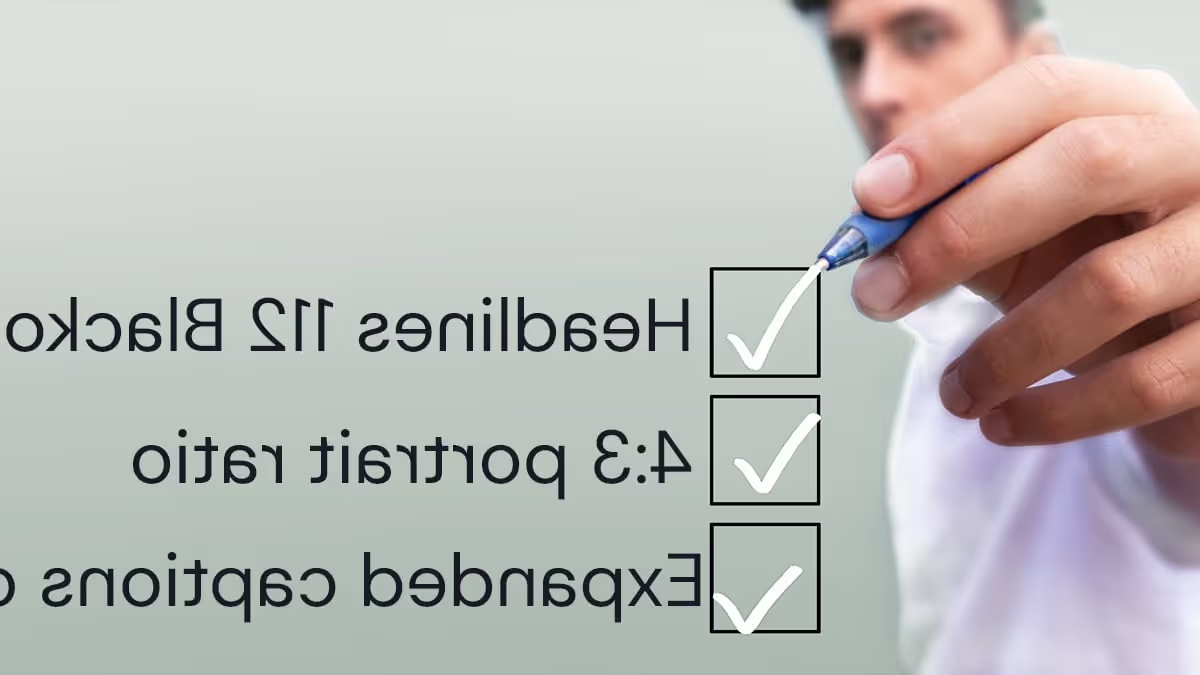
Yearbook spread checklists for student editing and grading
Raise your hand if you've made a mistake in the yearbook. Yup. The editing process for our small (read: five members) yearbook team transformed when we goofed up the spring sports section. Who noticed page numbers missing from the softball page? Softball players. Do you know who didn’t notice? Everyone else on campus. Regardless, that was the proverbial wake-up call this adviser needed to create a spread checklist to accompany the editing process. The flexible framework and quality assurance that came with its implementation simplified spread creation and elevated the theme elements.
List of things to include
If your goal is cohesive design and layout, include a copy of your style guide in your checklist.
Yearbook style guide ideas
- Font size and weight: heading, subheading, caption, body copy, portraits, rosters, pull quotes, group photos, folio/page numbers
- Text alignment rules
- Color palette
- Theme graphics: size, use case
- Photographs: borders, size, shape, alignment, spacing, rules on hand gestures and photobombs
- Banned words: favorite, family, this year, come together (these aren’t industry standard, rather my list of campus-specific cliches I’d rather not see again)
Pro tip: Set up photo and text styles in your yearbook editing program.
When do you need a yearbook spread checklist?
The quick answer: any time a spread is in progress.
Yearbook checklists provide a foundation, ensuring that students cover all essential elements of a spread—from images and captions to layout and design. There are no surprises. The checklist can alleviate surprises and questions such as, "What size are headlines again?"
At a minimum, spread checklists should accompany PDF proofs because we all do our best proofing after the book goes to print.
Using yearbook checklists in peer editing
The checklist becomes an educational resource in itself. It is a tool for quality control, enabling students to cross-check their work against established criteria. This fosters a culture of accountability and attention to detail.
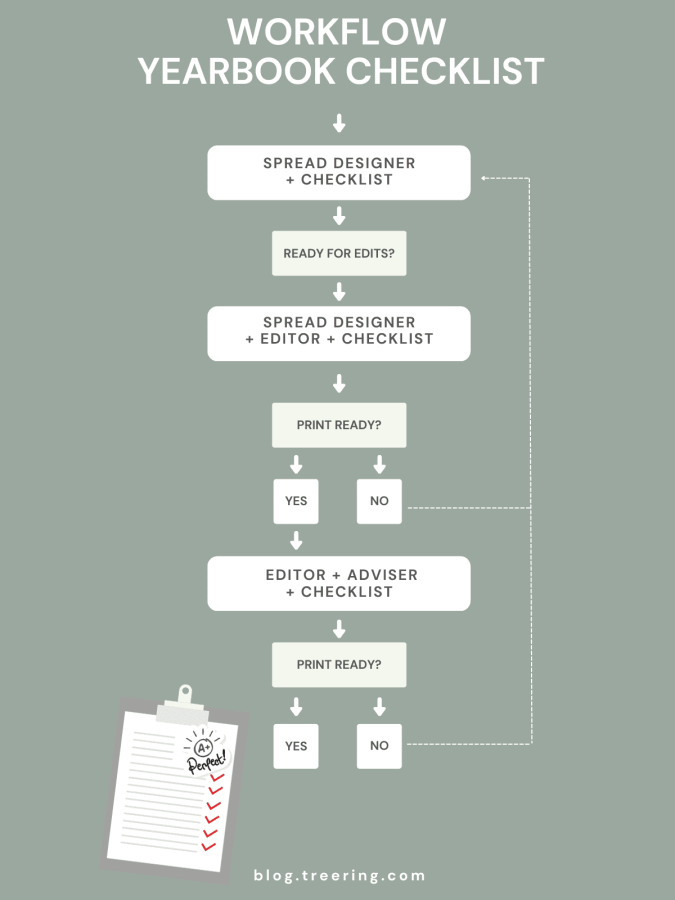
As students engage with it, they absorb design principles and begin to internalize design standards as they learn what works aesthetically. This learning opportunity extends beyond the checklist and contributes to the overall growth of emerging designers. (According to the folks at Cornell, peer editing increases student output.)
A checklist is not a rubric
In the educational realm, checklists and rubrics are like the Rocket Raccoon and Groot of assessment. Think of a checklist as your friendly to-do list; it's straightforward and lists criteria that need to be met. Using the cycle above, it’s a coaching tool that moves yearbook spread designers from blank page (scary) to complete and tells the story of the year (goal). On the flip side, rubrics break down criteria into levels, providing a nuanced understanding of performance.
In yearbook class, the spread checklist emerges as a non-negotiable tool for success. From providing structural guidance to serving as a quality control mechanism, its benefits extend to both students and advisers. For new advisers, it acts as a compass, while returning advisers find it a means to ensure consistency and embrace innovation.
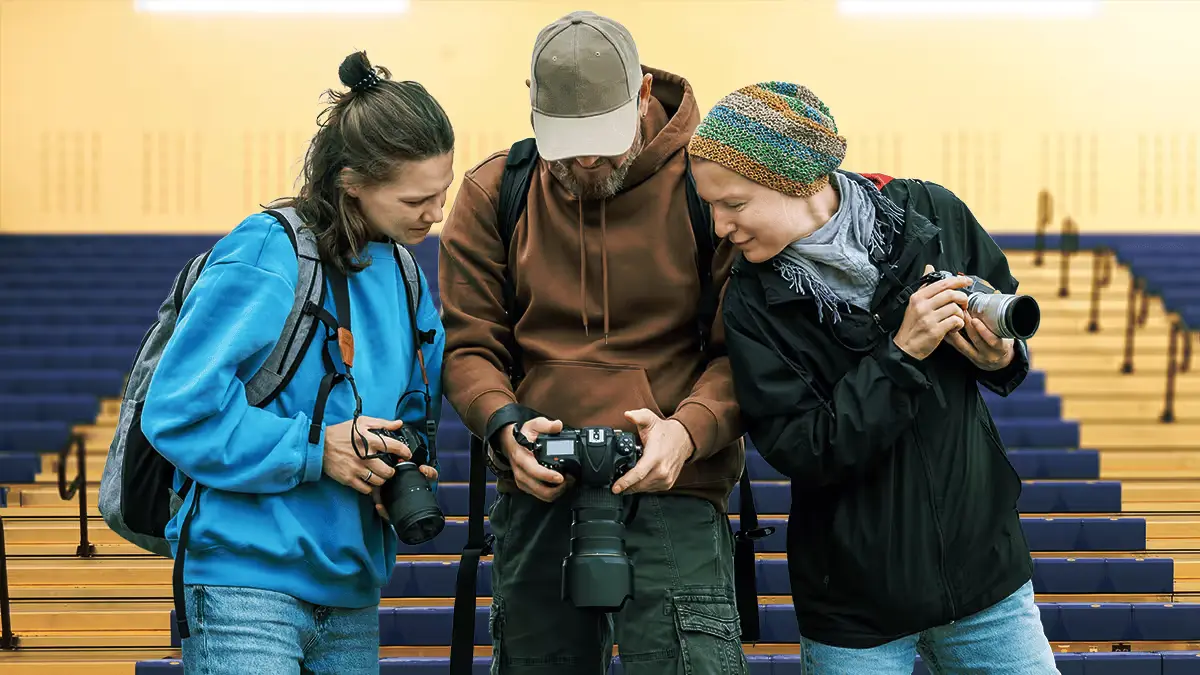
Two ways to improve your yearbook photography
By improving the composition and lighting of your photos, you’ll be able to use any device with confidence. While drool-worthy mirrorless cameras are all the rage and DSLRs “look the part,” cellphones, tablets, and point-and-shoots can also produce great photos. The key is your perspective and awareness of the action.
Composition basics
Composition creates compelling photos. When composing a shot, think about elements like background, framing, balance, leading lines, depth of field, and viewpoint. Even at sporting events or the school musical—when you’re limited on where you can stand—take some time to go through this list in your head to intentionally get the strongest photos.
In the digital age (did you read that in my grandma voice?), just clicking away and hoping for a usable image can be a waste of time. Being intentional for five to ten moments will help you anticipate action and yield more authentic images.
Background
If it’s not drawing the eye to your subject, you might want to get rid of it. Take time to assess what is behind your subject:
- If possible, remove distractions like garbage cans, signs, or other people
- At sporting events, stand on the opponent’s side so you get your fans’ reactions
- Position a photographer backstage or in the sound booth to capture behind-the-scenes action
Simple camera fixes such as adjusting the aperture (see “Depth of Field” below) or environmental ones (see “Leading Lines”) can help improve your photos’ backgrounds.
If it’s not drawing the eye to your subject, you might want to get rid of it. Take time to assess what is behind your subject:
Simple camera fixes such as adjusting the aperture (see “Depth of Field” below) or environmental ones (see “Leading Lines”) can help improve your photos’ backgrounds.
Framing
Your photos should focus on key interactions. For example, a tight frame on a student meeting their teacher on the first day of school captures a meaningful moment.
Alternatively, a wider frame might show the atmosphere of an event. Consider how close you want to be and what details you want in the shot.
If the event and space allow, move around to add diversity to how you frame your subjects. My yearbook adviser used to say, “Zoom with your feet.” It’s the second-best piece of photo advice I’ve received. (Lighting takes first billing for those of you playing along at home.)

Balance
While symmetry works well in group shots, you might also want asymmetry to draw the eye to a specific part of the frame. Think about how elements are weighted in the frame to achieve the mood you want.
In the example above, the laptop is what holds us captive.

Leading lines
Use natural lines—like desks, edges of buildings, or stripes on the school bus—to draw the viewer’s eye towards the subject.
Depth of field
This can be easily achieved with portrait settings on phones and cameras. Blurring the background adds drama and focuses attention on the subject. Whether you're using a DSLR or a smartphone, depth of field, or aperture, can elevate your images.
Viewpoint
Experiment with angles. Try taking shots from above, below, or behind to add variety and interest. Different perspectives help tell the story more creatively and capture aspects that a straight-on shot might miss.
These five lessons will help improve composition.
Lighting essentials
To say lighting is crucial is an understatement. In photography, too much or too little light can impact the photo’s quality. Be aware of your main light source. If you’re at an event, take a moment to assess from where the best light is coming.
Tips for indoor photography
Windows can be problematic if they are behind your subject. Unless you are aiming for a silhouette, keep them to your side.
If the lighting isn’t ideal, adjust. Sometimes, just asking students to move to a better-lit area can make a big difference. They’re usually happy to accommodate. For example, if you are photographing a dance, set up an area to take group photos with good lighting.
Using flash can also help in tricky lighting. For instance, in a situation with backlighting (like a window behind your subject), a fill flash will illuminate the subject and balance the exposure. In low-light conditions, adjusting your camera’s ISO or shutter speed with the help of a tripod can also help capture the shot without losing detail.
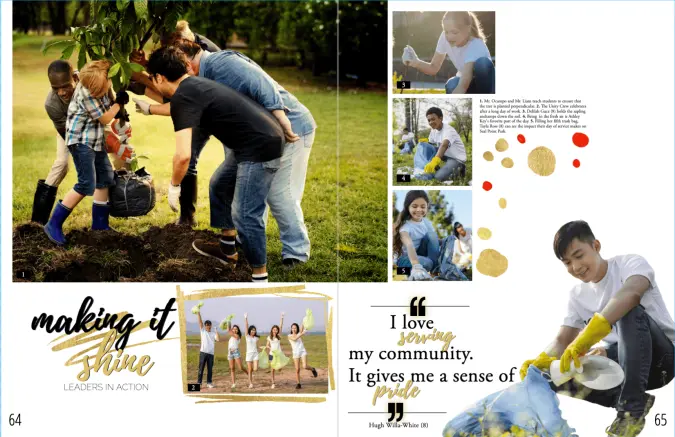
Outdoor photography considerations
Outside, natural sunlight is ideal, and just like inside, positioning is important. Move so the sun is off to the side or behind your subject to reduce harsh shadows and prevent squinting. Most professional photographers avoid outdoor photoshoots when the sun is overhead for this reason. (Basically, when the fun run is happening.)
We recommend using a tripod and angling yourself so the sun is at your subject's side.
Remember that a good photographer’s eye matters more than fancy equipment. Whether using a DSLR or a smartphone, focus on framing, lighting, and timing to compose meaningful moments.
This blog is adapted from Sandra Violette's Photography session from TRL 24 POV: I’m on the Yearbook Team. Violette, a professional photographer and PTO mom, serves on the Onboarding and Engagement Team at Treering Yearbooks.

Selling yearbook ads? Read this first
If you’re considering whether selling yearbook ads is right for your staff, you’re probably looking to take your team to the next level. Of course, it might also mean you’re hoping to satisfy a financial obligation to your yearbook publisher.
Yearbook ad sales can represent a fantastic learning opportunity. This process can empower your students with real-world skills, from pitching to potential clients to designing captivating advertisements. And the proceeds that come from selling ads to parents and local businesses can help offset or even eliminate the cost of many wish-list items.
However, if ad sales are necessary to offset yearbook debt instead of a way to benefit your program, Treering can help.
Define your goal
Before you think about ad sales, ask yourself: what’s our objective? Generally speaking, schools sell yearbook ads for one of four reasons:
- To teach business skills (sales, advertising, negotiation, and more)
- To purchase new equipment
- To help students pursue related learning opportunities
- To pay back existing yearbook debt
If your aim aligns with the first three, congratulations! Purchasing hardware and software that, in your staff's well-trained hands, will enhance your program for years to come is a fantastic achievement. And being able to do so self-sufficiently is even better! If you find yourself here due to the last reason, however, read on.
Cultivate favorable terms
There are many reasons your yearbook organization could be in debt. Perhaps you bought too many books last year (tip: not every company requires a minimum order quantity). Maybe unexpected charges surfaced on your final invoice or your per-book price seems high. Regardless, if ad revenue is solely meant to cover existing debt, it's a signal to reassess terms with your publisher.
The solution? Negotiate more advantageous terms. Open communication with your publisher can often lead to mutually beneficial solutions. Many publishers are willing to collaborate to foster goodwill and ensure continued revenue.
If renegotiation proves challenging, consider evaluating other publishers. Look for a partner that offers flexible terms, never requires contracts or minimum purchase requirements, provides inclusive per-book pricing without hidden fees, and offers school-friendly ways to raise funds.
Selling yearbook ads: the potential of your program
Your yearbook has the potential to not only capture memories but also generate revenue for your program. If you find it becoming a financial burden instead, it's a cue to reassess your strategy. Selling yearbook ads should be a positive venture, enhancing your students' skills and contributing to the success of your yearbook program. As you embark on this journey, keep the focus on empowerment, learning, and the enduring impact your yearbook can have on your school community.

Adviser advice: keep, change, stop
If starting the year with a yearbook debrief wasn’t possible or 3rd period publications popped up on your schedule the day before school started, start here. Keep, change, stop is a conversation to have as a team. Thumb through the yearbook, project some spreads on the wall, and complete a matrix. What aspects of your program are proverbial home runs and should be keepers? What needs to be changed? (Remain proactive and brainstorm solutions.) What needs to be stopped? At TRL 23, we sat down with four advisers to learn their takes.
Watch the full interview on Treering’s Facebook page.
Katie Thomas, Elk Grove, CA
We first met Katie Thomas when she became the yearbook coordinator for her daughters’ K-8 school midway through the year. As the lone parent volunteer, she sold 60 yearbooks in a week and now oversees the middle school club.
For Thomas, cover contests are a keeper. She said each year the school has a theme and she loves how the yearbook club chooses to “intertwine” it with the theme they select.
Moving forward, she’s going to change up the interview process for students in favor of more journalistic writing. “We want to make sure that there are more voices heard,” she said. “This is a student-produced yearbook.”
This year she stopped having multiple editors share a spread. “I learned the hard way,” she said about having students edit each other’s work without a formative peer editing process.
Janet Yieh, San Francisco, CA
Like Thomas, Janet Yieh began as a parent volunteer. Now, she’s transitioned the club from an after school activity to a school day program with 19 middle schoolers.
For the foreseeable future, Yieh will keep giving away yearbooks. Last year it was 100. “We are in San Francisco, and it's an urban environment. We have many families who qualify for free and reduced lunch,” she said. To ensure all eighth graders leave with a yearbook, she adds a small fundraiser to the cost of each book and pushes Treering’s early discount. Since many families take advantage of the sale, Yieh “buys into every single fundraising dollar.” To distribute the books, she creates a contest to win a yearbook so no one is singled out.
She is going to change up the class structure by inviting more experts to share with the club and creating some lesson plans for her students. Last year Yieh piloted this idea with her boss who went to design school. This year, an English teacher will guest teach on writing. “I'm a mom. I'm not a teacher,” said Yieh. “I'm trying to personally create curriculum for them to follow each week.”
While Yieh’s students led the design concept, she’s stopping their theme-less tradition. “If we create a foundation, it will be much easier when it's time to actually pop the photos into their pages.”
Chris Frost, Hemet, CA
“I was a student editor on this exact book, which I'm super proud of,” Christ Frost said. Because he knows the value of ownership, he keeps the tradition of a student-led yearbook program. “Our students decide everything. They pick our theme. They pick and design our layouts by hand because they like to struggle and fight with what a design should look like.” He and co-adviser Billy Valenzuela advise by keeping students on track towards their deadline.
The big change is how Frost’s students will increase representation in their yearbook. Historically, the team at West Valley High covers 80% of students beyond their school photo. That’s not enough. In repose, they created a B.O.L.O. (be on the lookout) wall with “ASB’s Most Wanted” using their coverage tracker. “It's also going to help us see who are those people that are hiding in the shadows that are in that background,” Frost said.
“This is their memory. This is their keepsake. This is a historical document. This is something that 10 years from now, 20 years from now, 30 years from now, they're gonna pull out and show family and there's nothing worse than opening that book up and your kid going, but where are you?”
Chris Frost
He stopped the way students received page assignments: instead of individual assignments, they are now in teams. Each team of five, led by one editor, works on five spreads at a time. Frost said, “They can delegate amongst each other… so it gives kind of a broader range on the pages.”
Beth Stacy, Huber Heights, OH
As a class adviser, Beth Stacy knows how much work her students do to identify each featured person in a photo, write body copy and captions, and place it beautifully in an effectively designed layout.
Without hesitation, she would keep grading spreads. “Every grade or every spread is graded on pass/fail,” Stacy said. The end goal of having all spreads submitted to Stacy print-ready means students are in control of their grades.
Stacy said, “Probably 95 to 98% of our book is taken by one parent who has kids in a bunch of activities, one teacher who is an amateur photographer, and then our professional photographer.” The yearbook culture change is student photography. She’s motivated by the fresh energy the younger team in her class brings.
Stopping the blend of chronological and traditional coverage is top of her list. After trying it for their 75th anniversary book, she said, “It got messy and didn't work very well.” Focusing on the traditional sections such as people, student life, and sports will help returning students train new ones and also balance the load for the few dedicated computers they share.
For more from these advisers, including their tips for getting started, favorite Treering hack, and application processes, watch the full video on Facebook.

5 yearbook fundraising ideas
Because we want our students to have the best equipment and experiences, sometimes we have to bring in extra cash. Heads up advisers: if you are looking for yearbook fundraisers to afford your book, stop reading this right now, and jump over to this article and learn how to have a debt-free yearbook program.
Fundraise by selling photos
First, the easiest way to raise money for your program is to use what you have: a captive audience, kids with cameras, and some pre-planned epic events.
1. Sell photos that are not in the book
How many times have you been asked for a copy of a photo your students captured at an event or game? Upload unpublished photos to a photo site and sell digital images or prints to parents and students.
2. Sell photos to local media
Smaller newspapers and local online news outlets will purchase athletics photos, especially in more rural areas. When you make your pitch, make sure you have a portfolio of student work.
3. Sell photo shoots
Another way to help your students build a comprehensive body of work is to offer photo sessions by your top photographers. Newer photographers on staff can assist: hold reflectors, take payment, upload, and retouch photos.
- Senior portrait mini shoots in a park
- Photo booth at Homecoming game
- Family photos at a winter all-school event
Fundraising with coverage
Second, you can add mini-ads throughout your book. These paid partnerships with parents, alumni, and business leaders don’t detract from your content and have the potential to add additional voices to your copy.

4. Page sponsors
In the folio, include a line that says “This page is sponsored by Williamstown Transportation” or “Congrats, Talia and the class of 2022! Love, The Cruz Family.” If you do traditional coverage, page sponsors can include club or athletic boosters whereas chronological coverage can be more event-focused: “QuizBowl Forever! Class of 1968 State Champs.”
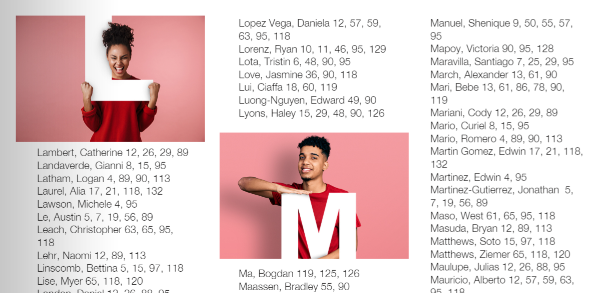
5. Index letters
If you could get 26 more photos in the yearbook, would you? Break up the index with fun portraits of students holding a letter. Some schools auction the honors, others issue letters on a reservation basis. To get the most out of it, compare your coverage report to your buyer list and see which buyers are in the book the least amount of times, offer index letters to those parents first, then go after students who are in the yearbook several times and have yet to purchase one.
Yearbook fundraiser 101: personal and business dds
Advisers use ads to teach business skills: project management, budgeting, and goal-setting. They work with students on talking points and help guide them to the right potential partnerships. It's the quintessential yearbook fundraiser.
Schools with supportive communities tend to do well with business ads. If you’re just getting started, begin by analyzing your area:
- Do you serve a transient population? Partner with realtors.
- Are many parents business owners? Show them how to feature their children in their ad.
- Do you have a bevvy of athletic sponsors? Work with your athletic director to bundle a stadium ad with one with the team photos.
- Are small businesses the norm? Add a business card section.
Whatever you do, don’t try to sell yearbook ads just to pay your yearbook publisher.
Remember the fun
Because fundraiser starts with fun (cliché, we know), your strategy should as well. Celebrate all your successes along the way. For some of your yearbook team, this could be scheduling a meeting with a potential sponsor and doing the presentation. For another, it could be selling 20 photos to your district PR agent and landing an internship. Everyone who buys in should reap some reward, even you!

10 reasons we're excited about TRL
Recreating the wheel is exhausting. Having Treering Live (TRL) experts provide all their tips and tricks saves time and energy and brings the fun back to yearbooking. (Yes, yearbook is a verb.) Treering tailored TRL for yearbook volunteers, educators, and aficionados of all levels, offering 18 sessions so you can engage with various aspects of the creative process. In anticipation, we compiled our top reasons TRL is the yearbook event of the season.

1. Leave with a road map
Figuring out how to get started when you're new to the school yearbook is daunting, especially when the person who used to do it is no longer at the school. Learn how to start and finish your yearbook.
Recommended sessions: I’m the Yearbook Coordinator… Now What? and Teaching Yearbook
2. Live event
Real-time sessions mean your questions get asked and answered promptly. Between the live Q&A during each session and the chat throughout, there are plenty of opportunities for shared learning.
Recommended sessions: Ask Us Anything with Treering’s Co-Founder Brady McCue and Keep, Change, Stop
3. Connecting with other advisers
Because two—or four hundred—heads are better than one, working together turns terrifying yearbook mountains into easy-to-approach small hills. TRL is not just about knowledge acquisition; it's about building connections within the yearbook community during National School Yearbook Week. You'll collaborate with fellow yearbook enthusiasts, sharing your triumphs, learning from your challenges, and forging bonds beyond these three days online.
Recommended sessions: Fundraising and Crowdsourcing and Social Media for Yearbook
4. Making a plan
From a ladder and coverage calendar to the next marketing campaign, you’re leaving TRL with concrete steps to make the best yearbook yet.
Recommended sessions: Getting Organized and Creating a Marketing Plan
5. Design inspiration
Yearbook Hero Lauren Casteen introduced us to mild, medium, and spicy design. Wherever you fall on this scale, you will gain an understanding of layout, typography, and color and how to go to the next level. You’ll also be able to help your yearbook team produce robust designs. Because, seriously, no one should yearbook alone.
Recommended sessions: Design 101 and Design 201
6. Three days of training
Joining TRL for one or all 18 sessions is a testament to your passion for preserving the memories and historical record of the school year, one page at a time.
7. cash
Kind of. Because we love a theme, there will be some sort of game in many sessions. Prizes include pizza parties, art supplies, and gift cards for coffee or Amazon.
8. 6+ hours of PD
Treering loves teachers. You’ll see learning outcomes in the session descriptions, and some of us, unabashedly, speak in teacher-ese. We know the importance of pro-grow opportunities. We know how annoying it is when someone reads their slides.
9. The Treering difference
Many schools consider changing their yearbook program and need to see Treering’s software firsthand. Busy schedules make it difficult, so we have four opportunities to dive in.
Recommended session: Live Demo
10. The journey isn’t over
In keeping with our game theme, your next winning move can take the form of weekly posts on the blog, monthly webinars, and 24/7 support with the Help Center. These myriad options allow flexibility in scheduling and enable you to revisit content or learn something new at your own pace.
Share your top moments during TRL: 23 by tagging us on social using @treering (Facebook and X) or @treeringcorp (Instagram and TikTok) using #trl23.
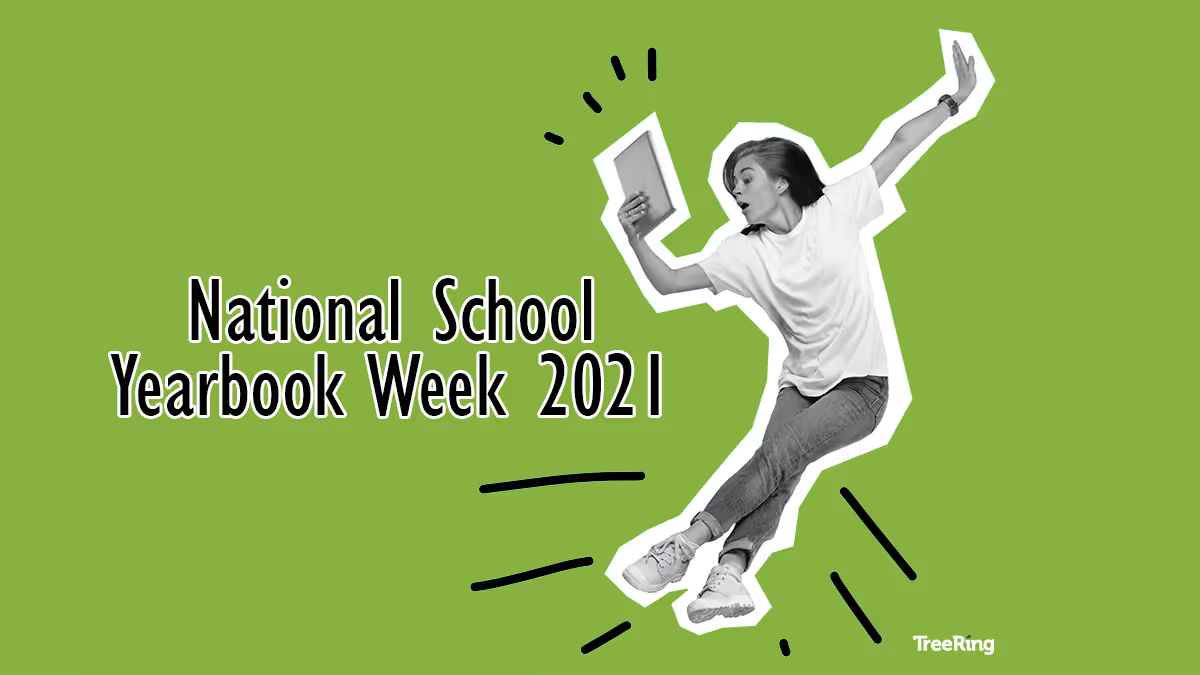
It’s national school yearbook week—here’s how we’re celebrating!
With Proclamation 5703, former President Ronald Reagan made yearbooks even more celebration-worthy by setting apart the first week of October for “appropriate ceremonies and activities” to recognize the creators and the power of a yearbook program. Nearly 30 years later, National School Yearbook Week remains a time to reminisce and a time to look forward.
Monday: celebrate the Heroes
For two weeks, we at Treering have been collecting stories of advisers, grandparents, parents, students, and school staff who make their yearbook successful. From collaborative efforts on original cover designs to timely communication on ever-changing school events, the positive contributions of many are making yearbooks happen.
Treering will announce the winners of the #YearbookHero contest. Schools can celebrate their own heroes by:
- Making banners to post on teacher’s doors to say thank you
- Sharing on social media photos yearbook heroes have shared with your team or a photo of a yearbook hero with a description of why he or she saved the day
- Hosting a pizza luncheon for your yearbook team, because pizza and yearbook are a clutch combo (Was that too cheesy?)
- Decorating your yearbook students’ lockers

Tuesday: celebrate the product
Just like VH-1’s Behind the Music series, you can do a Behind the Yearbook and showcase the story behind previous years’ themes or a yearbook staff member’s journey. Other fun ways to show off the importance of yearbook on social media include:
- School staff show off their old yearbooks photos
- Highlight important events such as State Championships or famous alumni in previous yearbooks
- Record a teacher or student reading encouraging messages from his/her yearbook
If you haven’t yet branded your book, National School Yearbook Week is the ideal time to do a theme reveal! Some schools make a video to share, others reveal just a theme element or two to tease buyers.
Wednesday: celebrate growth
Mid-National School Yearbook Week, yearbook lovers will unite. For the first time (in forever) Treering is inviting yearbook coordinators and advisers to gather for an epic evening at Treering Live! In addition to breakout sessions for Elementary and middle/high schools, attendees will glean practical ideas on how to
- Sell more yearbooks
- Create an epic yearbook theme
- Overcome common objections
- Take newsworthy photos... on a cellphone
Follow #TRL2021 for Tweetable takeaways your fellow yearbook advisers shared, and work with your team to apply a few this year. We always say, try one or two new things (Treering loves yearbook advisers too much to let you try and do it all!)
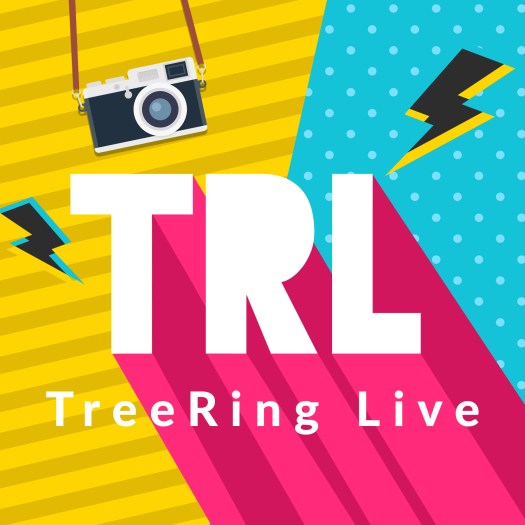
Thursday: build on the momentum
Now that a few days were filled with celebration, take some time to use National School Yearbook Week to propel your team. Collectively, identify what is going well and why. Check your progress towards your goals for the year and ask:
- What is working?
- What needs improvement? How can our strengths help in this area?
- Do we need to refine any goals?
- How will we celebrate reaching our goals?
Schools that see success with goal-setting and achievement monitor progress and also make their goals attainable. Instead of sell more books, try something like if we increase our yearbook sales by the end of December, we will have an ice cream party when we return to school in January.
Fri-yay: #feelgoodFriday
You celebrated. You learned. You strategized. As you prep for some #weekendvibes, take one more opportunity to build unity among your team. Whether your YB teamis made up of students in an after school club or for class credit, or your shepherd a super squad of parents, create a feel-good moment to close out National School Yearbook Week.
With students, a chain of strength is a way for students to self-assess their team contribution. After a brief period of individual work, the group discussion is where the magic happens: students encourage and build up one another. (Pro tip: get paper in your yearbook theme colors to make your team’s chain.)
Parents too need edification. A quick trip to Dollar Tree for some fun thank yous will go a long way: incense for the wise moms, a skein of yarn for the dad who holds it all together, or a trivia book for the parent who is a lifelong learner. Focusing on the strengths of each team member, and celebrating their individual contributions, created a culture of support. This is key for collaboration.

Never yearbook alone
This is the heart of Treering’s Yearbook Club webinars. Teachers looking for classroom support and parent volunteers looking for a launch pad can find resources and how-tos throughout the school year at no cost.

Synchronous instruction
If you don’t speak teacher-ese (or don’t care to on your prep period), this just means it’s live. This real-time interaction means attendees receive instant responses to their questions. (Full disclosure: occasionally, we divert from the script because the group’s needs demand it.)
Direct access to expertise
See what happens when you bring together staff members from product knowledge, marketing, and community advocacy. No PowerPoint slides. No hypotheticals. All yearbook.
We believe in show and tell
Starting at Treering.com, every webinar shows you how to create, get inspiration, and receive help. We show you how to customize your styles and settings, find marketing materials, and maximize the automations in Treering’s yearbook builder.

Each month, new advisers can join a Getting Started webinar to get an overview of the design and print process. As you progress through your yearbook journey other webinars are available, including Treering Live, our flagship virtual yearbooking event and topical sessions on portrait, advanced design, and theme development.
Your yearbook your way
Yearbook creation isn’t a one-size-fits-all process. Neither are Yearbook Club webinars. We’ll show you all your options to make your yearbook represent your population, from changing up backgrounds to creating custom word art.
The Yearbook Club team releases new Tip Tuesday videos each week on YouTube.
Community
Call it networking, if that’s your thing. In the live chat, attendees exchange ideas and strategies.
On a personal note, I’ve met some yearbook advisers in the chat who have become contributors to this blog, and I’d like to think lifelong friends. We celebrate professional and personal milestones together. Occasionally, family pics pop into my inbox, or we text a timely yearbook meme.
No one else understands what being a yearbook coordinator is like outside this small world. I’m going to seek support from those who do.

